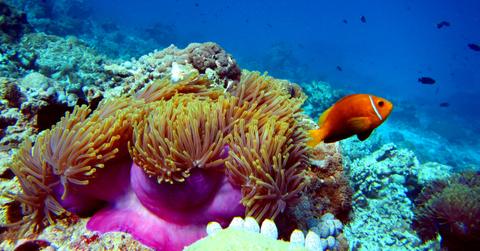This Robot Just Delivered 100,000 Baby Corals to the Great Barrier Reef
This could mean a major change for the Great Barrier Reef.
Updated Feb. 4 2019, 2:28 p.m. ET

The Great Barrier Reef has seen better days; in 2016 and 2017, the coral that made up around half of Australia’s Great Barrier Reef died off due to the effects of the constantly changing climate and the emissions of greenhouse gases in our environment.
The Reef is home to countless species, who are rapidly losing their home despite the best efforts by scientists to intervene and save the Great Barrier Reef. And the latest update could be one of the promising for the 1,400 miles of colorful corals. Researchers at two different universities in Australia recently rolled out an underwater robot designed to repopulate the reef.
LarvalBot is a briefcase-sized vessel that’s moving along the damaged sections of the Reef, seeding with them with more than 100,000 microscopic baby corals with the hopes that the Reef can be restored to its former (necessary) glory.
Peter Harrison, the leader of the restoration project and the director of the Marine Ecology Research Centre at Southern Cross University, explained, “The reduced numbers of corals means we’ve lost the ability for coral to provide enough larvae to settle and restore these communities quickly. The idea here is to use an automated technique that allows us to target delivery of the larvae into damaged reef systems and increase the efficiency that new coral communities can be generated.”
In a trial run of the LarvalBot, the robot distributed babies that were derived from the corals that survived the bleaching and the oceanic effects of climate change, as it's believed those reefs are the ones most likely the tolerate the warming temperatures. Harrison told NBC News that future versions of the bot may be able to disperse millions of baby corals at once in order to make the future regrowth of the Great Barrier Reef a reality. For now, the researchers have to wait and see if babies take hold before they decide their next step.
“We can’t actually see the results of these experiments until we start to see juvenile corals grow‚ so for at least six to nine months,” he explained. “What we’ll be doing now is monitoring the reef over the coming months.”
This isn’t the first innovation that shows promise when it comes to restore corals and the Great Barrier Reef; last year, a marine researcher named Dr. David Vaughan postponed his retirement after accidentally learning a new way to restore damaged coral reefs. His system, known as microfragmenting, allows corals to grow 40 times faster than they would in the wild. While it isn’t a permanent solution, he warns, it’s a step in the right direction.